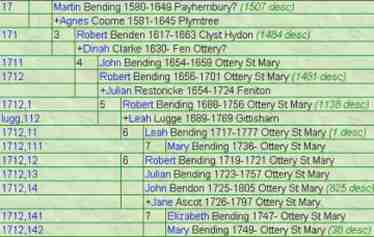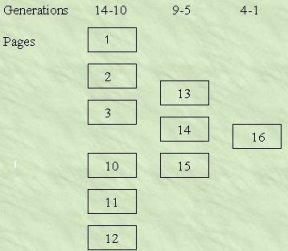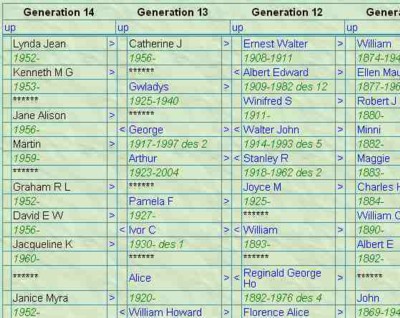The format of the traditional family tree, with the progenitor at the top and the latest generation at the bottom, presents problems in presentation in that the width becomes excessive once the number of members in a generation becomes large. The Bending family has 1470 members over 15 generations. The largest generation, the 12th, has 290 members, and allowing one inch per person, would require a width of about 25 feet. Height is not a problem as allowing one inch for each generation, 15 generations plus a heading would need a height of about 18 inches.
An alternative is the descendant tree which is arranged to give one line per individual, in henry number order, and to stagger generations by say a third of an inch. If three inches are allowed per person for name and details the width of an A4sheet would be adequate for 15 generations, and the length would take about 50 persons, 1470 persons would require about 30 sheets. Display on a computer, with scrolling, takes up a similar number of virtual pages

A difficulty with the descendant tree is that early families may be widely dispersed as all the descendants of one father are displayed before returning to a sibling. The traditional family tree shows a generation in each line, or row, generations are separated vertically, and each row includes all persons in that generation. A descendant tree shows generations in overlapping columns with a person in each row. Both methods make use of henry numbers (which may be seen on the left in the illustration), the family tree shows each generation in henry number sequence horizontally, and the descendant tree shows all generations together in one henry number sequence, vertically, hence the separation of families. A possible alternative is to rotate a family tree through 90 degrees, clockwise. Generations being shown in columns, each column showing all individuals of one generation, with families grouped together. The latest generation being on the left and progressing to the first generation on the extreme right. The individuals in each column, that is in each generation, is in henry number sequence. This is the purpos of the design. The design is intended to show the ascendant tree on a computer screen in virtual pages, and in this format it is possible to show five columns (generations) on a page. To make the pages compact only members of the family, and not spouses, are shown, and information on each person is limited to dates of birth and death, and the number of descendants. This information is shown below the name so that there are two lines for each individual. Pages have a minimum of 26 individuals, that is 50 lines, and the number of lines is increased if otherwise families would be split between pages. The most recent generation of Bendings, the 15th has not been included in the tree as it is far from complete, and this leaves 1264 Bendings in 14 generations. With this number the tree requires 16 pages, 12 pages of generations 14 to 10, 3 pages 9 to 5, and 1 page for the first four generaions. The arrangement may be likened to three folders, the first holding 12 pages, the second 3 pages and the third one page. |

It was decided that the output would be in html as this has significant advantages over alternatives, it is a universal language, output may be written to cd and could be accessible anywhere, it is the language of the web, and the tree could be uploaded to a site and be widely available, and it has the ability to make hyperlinks and thus solve the problem of connecting children and parents, which otherwise would necessitate the use of lines or proximity. Another function of hyperlinks could be to connect two or more ascendant trees where, say, a wife in one tree is the daughter in another, and a link would enable a move between trees to be made. Hyperlinks are also used to connect pages within a folder, and to connect individuals with personal information on the site
Links may be seen in the illustration, "<" is a link to the first-born child from the parent, > is a link to the parent from the first-born child, each name is a link to personal information To use the tree, access from any source shows the subject on the top of the screen in one of the five columns, if there is "<" on the left of the name selecting this symbol will bring the first-born of the subject to the top of the screen in the column to the left, or if there has been a folder change, to the rightmost column, if there is a > on the right selecting will bring the parent to the top of the screen to the right, or if there has been a folder change to the leftmost column, if there is no > symbol then scrolling up the family will lead to the first-born in the family being shown with a > to the right, selecting will bring the parent to the top of the screen as before. Folder changes take place when, in looking for a child, the subject is in the leftmost column, or in looking for a parent the subject is in the rightmost column. The programming for the tree involves three operations: to gather all the relevant data in a file with one record per individual, that is a list: to sort and arrange this information in a form which allows the translation into html in a suitable format, this file has a record for each line in each page: and finally, reading one line at a time, the actual conversion from one language to another, and the division into pages in an easy to read format. The running time of the program processing data of 1264 persons is aboput 15 seconds John Bending - July 2004 |
|
Since this article was written another 400 names in 11 families have been added. These families; Binding, Bovett, Brice, Channon, Eden, Eveleigh, Fronks, Glass, Mildon, Rabjohns, Slay,and Bendings; are interconnected by marriage, the point of interconnectiom being a spouse in one family and a daughter or son in another. The interconnection is shown by the letter X which is a link to the other family. JB - February 2005 |
